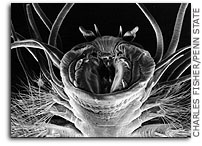Scientists Discover Methane Ice Worms On Gulf Of Mexico Sea Floor
 (larger view) |
mini research submarine on a NOAA-funded research cruise has discovered,
photographed, and sampled what appears to be a new species of centipede-like
worms living on and within mounds of methane ice on the floor of the Gulf
of Mexico, about 150 miles south of New Orleans.
Although scientists had hypothesized that bacteria might colonize methane
ice mounds, called gas hydrates, this is the first time animals have been
found living in the mounds.
The discovery of dense colonies of these one-to-two-inch-long, flat,
pinkish worms burrowing into a mushroom-shaped mound of methane seeping
up from the sea floor raises speculation that the worms may be a new species
with a pervasive and as yet unknown influence on these energy-rich gas
deposits.
The worms were observed using their two rows of oar-like appendages
to move about the honeycombed, yellow and white surface of the icy mound.
The researchers speculate that the worms may be grazing off chemosynthetic
bacteria that grow on the methane or are otherwise living symbiotically
with them.
"The old view that the deep sea bottom is a monotonous habitat
needs to be discarded. These worms are the major players in a new and unique
marine ecosystem," said expedition Chief Scientist Charles Fisher,
an associate professor of biology at Penn State, who discovered the methane
ice worms in waters 1,800 feet deep in the submersible Johnson Sea Link
with sub pilot Phil Santos of the Harbor Branch Oceanographic Institution.
The scientists have also managed to keep a number of the exotic worms
alive in shoreside laboratories for further study.
"These are not just another common worm in the mud. We now know
that these higher-order organisms can live right on methane hydrates. If
these animals turn out to be ubiquitous on shallow seafloor gas deposits,
possibly worldwide, they could have a significant impact on how these deposits
are formed and dissolve in seawater and on how we go about mining or otherwise
harvesting this natural gas as a source of energy," Fisher said.
"It’s very cool that while we’re busy speculating about life on
other planets we continue to discover new forms of life in the most unlikely
habitats on Earth," commented Erin McMullin, a Penn State graduate
student and a member of the research expedition that discovered the methane-ice
worms. Methane ice, a gas hydrate, forms naturally at the high pressure
and low temperature of the deep sea, but is usually buried deep in marine
sediment. The Gulf of Mexico is one of the few places where hydrate can
be found exposed on the ocean bottom. Occasionally this seeping, solid
methane bursts through in mounds, often six to eight feet across.
The first leg of the ten-day expedition, which ended July 19, was carried
out aboard the Harbor Branch Research Vessel Edwin Link and sponsored by
the NOAA National Undersea Research Center at the University of North Carolina
at Wilmington and the Minerals Management Service of the U.S. Department
of the Interior. In addition to Chief Scientist Charles Fisher, principal
investigators included Ian MacDonald of Texas A&M University, Robert
Carney of Louisiana State University, Steve Macko of the University of
Virginia, and Alissa Arp and David Julian of San Francisco State University.
A second leg of the expedition, sponsored by MMS and NOAA, continues
through August 1.
**dk**
Contact: Barbara Kennedy at Penn State (814) 863 4682, science@psu.edu
Dane Konop at NOAA (301) 713-2483, dane.konop@noaa.gov
NOTE TO EDITORS:
Broadcast-quality copies of the imagery of the worms and their hives in
the methane ice are available by calling 301-881-0270; network affiliates
should call their Washington, D.C. offices. For still photography or to
arrange an interview with Chief Scientist Charles Fisher, call Barbara
Kennedy at 814-863-4682.
To interview Ian MacDonald at sea, call Pam Keen at 561-465-2400 (ext.
271). Call Sarah Sue Goldsmith at 504-388-3871 to interview Robert Carney.
Call 619-696-0234 to interview Steve Macko. Call Merrik Bush at 415-338-6747
to interview Alissa Arp or David Julian.
For additional information and ~300k computer-viewable pictures, visit
the following World Wide Web site: http://www.bio.psu.edu/fisher/main.html.
To download publication-quality images from ~1.3 meg to ~ 4 meg, visit
http://www.science.psu.edu/iceworms/iceworms.html
All NOAA press releases and links to other NOAA material can be found
on the Internet at http://www.noaa.gov/public-affairs.
Journalists who wish to be added to the NOAA press release distribution
list, or who wish to switch from fax to e-mail delivery, can send an e-mail
to releases@www.rdc.noaa.gov,
or fax to 202-482-3154.
Press releases concerning research in the Penn State Eberly College
of Science can be found on the Internet at http://www.science.psu.edu/alert/.
All Penn State press releases are located at http://www.psu.edu/ur/.
Journalists who wish to be added to the Penn State Newswire, a daily e-mail
distribution list, can send an e-mail note to pat5@psu.edu.









